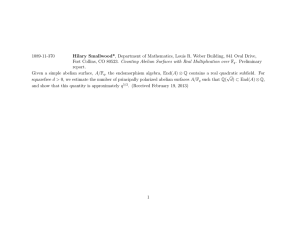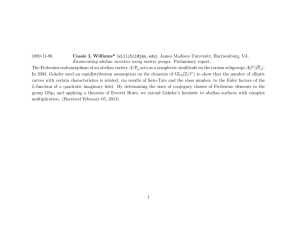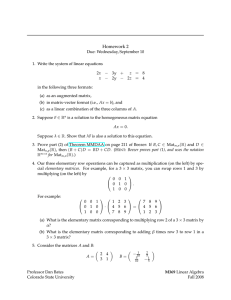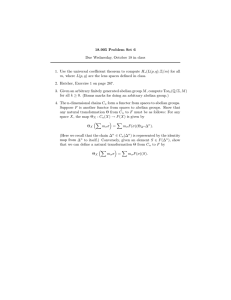of The NO.40 OF
advertisement
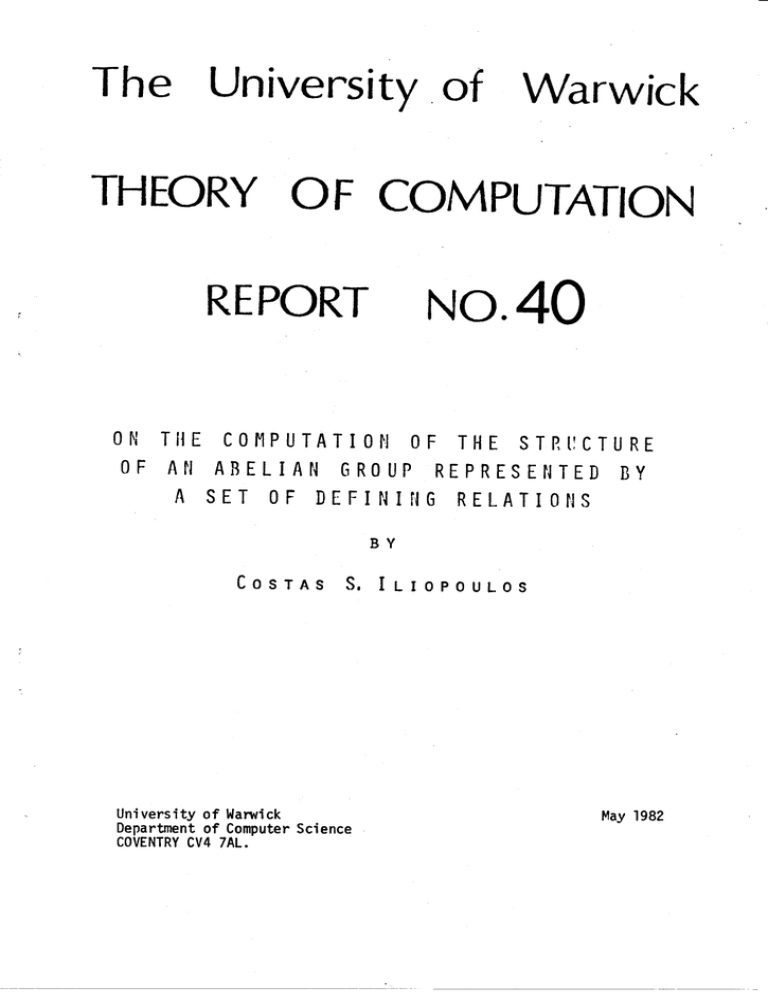
The University of warwick
THEORY OF COMPUTATION
NO.40
REPORT
ON TII E COl{PUTATION OF THE STIlI: CTURE
()F AN ABELIAN GROUP REPRESENTED BY
A SET OF DEFINI'.IG RELATIONS
BY
CosrAs S. Ir-topouLos
University of l'|aruick
Department
COVENTRY
of
Computer Science
CV4 7AL.
May 1982
ON TEE
COMPUTATION
AN ABELIAN
OF
OF
TTIE STRUCI]TIRE OF
GROUP IEPRESENIED
BY A
SET
DEETNING RELATIONS
S. Iliopoulos,
Ilniversity of Wanrick,
Department of Conputer Science,
Costas
Coventry CV4 7EL,
United Kingdon.
February
1982
To My Parents
/-'t
1.
INTNODUCTION
ttrat tbe set
sx.x.rl*iri)
n
*"oi
7(i (n- c..
tLj' € v.x.*j -*j-'i'
--tzi
*o^^'=f,
= 7 J(i(rnr
K-txfr,- "Jir *Zo'
Suppose
is a set of defining relatione for the abelian grouP G and Let c be an
In this paper, the computational complexity
mxn mptrix with c = ("ij).
of the problem of eonpuEing the order and the structure of a group G'
given R, ie examined.
in elementary operations'
bit or
An elementary operation is a Boolean operation on a single binary
pairs of bits. The size s of an mxn matrix C = ("ij) ' is the number
Ttre coruplexity
of an algorittrm ie
measured
m+n+logl0ll
where lcl = rtraxtl"rrl].
IJ'
i,i
that in the case of a finite group G, represented by a
matrix c of si ze 6, the otder and the structure of G can be computed in
It i8
ehown
polynomial time. This computation requires O(85 M(s2)) elementary operations'
for the
where l4(n) denotes the number of elementary operations required
multiplicationoftwointegersofl.engthatmostnbits.
Also it is given an upPer bound for the time reguired to
compute the
structure of an infinite group G is also given. Ttris computation requires
O(zr*e) eLernentary operations, where r is the rank of the matrix representing
the grouP
G.
Sins in [4] forrnulated the classical algorithm for the above problem
without analysing its computational couplexity'
NOTATION
Rowa(i) and COLa(i) wifl be ueed to denote the i-th row and the i-th
coluunr
of a matrix
C respecEively'
-1-
'tr
An integer row-colurm operation (IRC operation)
(i)
The
or
(ii)
Ttre interchange
or
(iii)
Ttre
multiplication of all the
of two
of a row(coluurn) by -1
rowe(colurnns)
addition of an integer nultipLe of row(colurn) to
different row(coluur)
2.
elements
is said to be:
a
.
T1IE COMPINATION OF TI1E DEIEBULNAN1I
Suppose
that an abelian
with integer entries,
is the
number
group G is
grouP G
where m
is represented by an mxn natrix
is the number of defining relations
of generators. firen it is not difficult to
finite if
and only
show
C
and n
that
the
if
ranka(c) = n
where Q denotes tl'.e
field of rationals.
or not G is finite by
Hence one can decide whether
Gaussian
2.L
means
of
elinination on C.
PROCEDURE DET
Procedure
DET(C)
Cormnent Ttris procedure coqutes the deteroinant (for square matrix only)
and the rank
of
an mxn matri.x"C(w.1.o.8.
m
) n is
assunpd)
Begin
i<-o;
1.
whiLe
(
C
is not in echelon
form
)
do
Begin
i
<- i+1;
RoW(i) and ROW(j)
if c.,
= 0 then ( interchange
r.l
u.
'J + c,, / c* for i < j -< m;
I.1
J1
ROI.I(j) <- ROw(j)
3.
4.
- u. ROw(i) for i < j
J
-< mi
end
Return
DET(C) =
(if
I .ii
C
end n
-2-
ie
square)
'
RANK(C)
= i;
where
c.*ts,jti
J4
>
The procedure DBT
PROPOSITION 2.2
and the rank of a
correctly
computes
the deterrninant
natrix c in o(g3lt(s2)) elementary operations,
is the size of the matrix
where
s
C.
Proof
l,.t c(i) denote c at the beginning of the i-th iteration of
L-4.
Step 3 requires at mo6t mr nuLtiplications or o(ur M(logllc(i)tt))
elementary operations.
o(
loop
Hence the procedure requires
at
most
m(
r dr M(ro4 c(i)n )) elementary operations.
i=1
Now
using the formula (12) in L2J (p.26), one can see that
tt
c(i) il = o((iu
Hence rhe procedure rerminates
REI'IARK Step 3
raul
tipL i cat ion
in
of the prooedure DET
R.
C
r
cil )
O(n?n
i)
M(log(nllcl|l)) = o(ss M(sz)).
can be expressed as the matrix
where
,
0
,,1
ui*1'.
,.
:
.n
.|.rl
"1
e-
u'.m
+
i-th
llence
it
rnay
columr
be helpfu]. to use the fast matrix uultiplication
algorithms (see [3-l for the computation of step 3. It is vtorth mentioning
here that Strassenr s aLgorithm for matrix nulLiplication (see [1]) is not
suitable for matrix nultiplication over the rationals, since it uses
a
large number of additions and an addition over the rationals costs three
integer mu1tipLications.
COROLLARY
2.3
There
exists an algorithm which
decides whether
or not
abelian group G represented by a matrix C, is finite or infinite in
o(s3 M(s2)) elementary operations. I
-3-
an
3.
'IIIE ALGORITH}I
5 f *Es€*EeG
=:L-e :L--r'@sf--r
3.1
T}IE
Ttre
I.R.C.
TOR.
]IINII'E
GzuUPS
s*
OPERATIONS
I.R.C. operation transforus the matrix
C
of the set of defining
relations of an abelian group G to a matrix C* which represents the sar:ie
group.
The interchange
of
rows
yieldg the set of defining relations
c..
reordered, the multiplicaLion of a rovr by -1 substitutes the reLation IIx. tJ=1
i1
for the relation - *.-ij=1
the
addition
of
and
an
integer
multiple
of
a
i 1
c..
c..
K1=1].
rohr to a different rovt substitutes the relations {II x. 31=1. l.[ x.
I
i
i I
The interchange of coluuns corresponds to the renaming of the generatora,
the multiplication of a colurrr by -1 is the substitution of the generator
for the generator x
different
3,2
colurmr
and the addition
of an integer multiple of a coluurr to
substitut." trryP, y) for {x, yi.
BACKGROUND FOR TTIE AIGORITHM
A.
Given an mxn rnatrix C representing
a
finite abelian group G,
the algorithm transforms C via IRC operations to the matrix of the form
"11
where
11
-.
,.
I "r.*,. , i+r, 1 -.i{n.
GN
"r1
r+here l^c,,
11
B.
o
The
L
form of the matrix innplies that
x ".. x
.{,
c
nn
for
is a cyclic group
' of order c.r,
lt--
1 -<
i
-< D.
In the case m = n = rank(C), the order lCl of the group G can
be computed by means of Gaussian elimination, since
lcl
r,-1
= der(c).
-4-
a
In the
case m > rr = rank(C), there
exist n linearly
independent rows
the rationalsrsay, ROW(j.), 1-< i.g n. If Cr = (ROW(j1),""
group F is
ROW(jn))T r"pr"rents an abeLian group F, then the order of the
of
C over
lrl Moreover, since G is a subgroup
det(Cr)
of F, it follows
Lhat
(3.1)
lrl =o(moalcl)
the order lCl of group G represented by C, then it is
not difficurr ro see rhat the matrix cr' = ("ij ), with "ij = c''(moalcl)
representing the sarne group. And sinilarly, if one knows a multiple of lCl
Hence,
if
one knows
(e.g. irl above), then the matrix Crr' = ("ij')
represents the same grouP.
3.3
with Cl't = "ij(nroalrl)
THE AICSRITTIM
a finite abelian group
INPUT
:
An mxn matrix C representing
ouTpuT
:
The canonical strueture and the order
of the group
G
G
PROCEDURE ELIMINATEROI'I(C'P,D)
conment The procedure transforms c via IRC operations to a matrix
having Row(p) = (al ,12,...,"nror "'ro) ' Ttre parameter D is a rnultipl-e
of the order of the
grouP
if
one
is known, else
D=
-(x
mod- :=
xrv x e
Z)
Begin
while c-:
f o tor
frr
some
Pt i Sn
do
Begin
I
<- index{
(
conryure
{ l"-i | > o}}
lc-r
'p^ I = titt
p.<j.<n yJ
ekr fk, p < k < n
COt(k) <- COL(k)
- "t
end
"pk
- % "nn + fu with lrtl'
mr(p) (rnod D) for p < k s< ni
end
Esls
:
c;
.
-5-
"no
"t
Ina similar way the procedure
ELIMINATECOL(C
,p,D) is defined.
PROCEDUR!] DrAG(C,D)
Comnent This procedure Eransforms the matrix C via IRC operations to
a marrix Cr =
(c'ij) *iah
"ij
= O for
i + j.
Begin
p
(i)
<- O;
while .rj.j r* o for
some
i f j
ao
Begin
p + p+1;
while (
(ii)
c _:
p1
f otorsomep<i.<n)do
Begin
(iii)
ELIMINATfiROW(C,p,D) ;
(iv)
ELIMINATECOT(C,p,D) i
end (etep
(v)
(vi)
end
(ii))
(step (i))
Return C;
end
Ttte
.
main algorithrn
is the foLlowing:
Begin
det(C) (ff C non-equare,
1.
D <-
)
IfD=Othen
D <- ( a minor determinant of
D
+
C
o) i
of rank r = rank(C) >;
G <- DrAG(C,D);
3.
.( Transform C via IRC operations to a matrix C such that the
ie eorted by increasing order > ;
sequence {"11r...r"rr}
4.
* .i."iii
1=I
5.
D
6.
while ( c:.:
:.a for somc 1.. i { 1)do
a+rr1+r
11' t c,,i
Begin
( let c:
t ca+lra+l for some
"oo
( compute vt t : cc+lra+l =tc
+
O
/"
/dc
I oc c.+ Lra+trl\ +DIAG
\
7.
B.
'(t*","
end (step 6)
9.
end.
n
-6
s a s r and "iil"i*l,i*l
v with l"l . lcccl/z >;
""\
vl
i<o
PROPOSITION
3.4 Algorithn 3.3 correctly
of the finite abelian group G in
matrix
compuEes
the order and the structure
O(s5 M(s2)), where
s is the size of
the
C.
Proof
The correctnesa
of the algorithm fol"lows from observations in
53.1 and $3.2.
Stepe 1-2 require O(s3M(s2)) elementary operations by Proposition 2.2
and the remarks
of 53.28.
Moreover
roglol r. log(nl Icl]
Slnce D + O, it is not difficult
ELIMINATER0W
to
(3.21
-< s2
that the procedure
show
(respecrively ELIMINATECoL) requires o(us2M(loglDl))=O(us2M(s2))
elementary operations, where p
is the nunber of iteratione required by
the
loop of the procedure. Moreover
(i)
l"nnl
(i)
where
(i-r)
-. | "nn ltz
cpp denotes cpp at the i-th iteration of the loop of the
ELIMINA]SROW
(respeetively
(3.3)
procedure
ELIMINATECOT) .
that in the procedure DIAG the loop (ii)-(v) requires g
iterations, and rhat ujrrj, 1 { j -< B, denotes the number of iterations of
the l.oop of rhe procedure ELII{INATEROW and ELIMINATECOL respe-ctively at the
Suppose now
j-th iteration of the loop (ii)-(v).
5
i
Then
usins (3.3) we have
(u.,+vr) *< roglol -.
J
j=l J
Hence
loop (ii)-(v)
requires O(s4 M(s2)) elementary operations and moreover
procedure DIAG terminates
Now
s2
in
O(s5 M(82)) elementary operations.
step 4 requiree O(s3 log s) elementary operations by using an
a
sorting algorithm which requires O(e log s) comparisons (see [11).
In a similar way, as above'one
can show
that stepe 7-8 require
((s2 M(s2)) elementary operatione. l'{oreover, loop 5-9 requires at
-7-
most
.n
I log n = o(s3) iterations and thus
'l
Loop
6-9 requires O(ss lt(u2))
=r
elementary operations
.
From the above analysis the proposition follows. tl
.4-,-'
TIi9:A!GO
Suppose
matrix
via
that an infinite abelian group G is represented by
with r = rank(C) < n,
Cu
IRC operationa
In this ca6e, the natrix
to an mxn matrix of the
/ r\
lco I o
\ tl
where C't
is
an
is
mxn
transformed
form
(4.1)
I
uxr matrix with rank(C:t) = r.
algorittrm 3.3 to C* to obtain the structure of
T,he
C
an
Then one can apply
G.
transformation can be done in a simil-ar Lray as in algorithn 3.3
using the foLlowing algorithm:
.AICORITTi}I
4.7
infinite abelian group G
INPUT
:
an mxn matrix C representing the
OUTPUI
:
The order and the canonicaL structure
of
G.
Begin
r+rank(C)
;
L" &:p=1jg:
t,io
B"gin
if ( c . = O, for all p -. j -. n )
PJ
then
Begin*
tr <- index{R0w(r)
< Interchange
| c,, f o for
J
some p -<
R0W(tr) and ROW(P)
);
enq
ELII'TXNATEROW(C,
2,
P,-)
i
_e3c!
e* e- as it is in (4.1)
end. n
-g_
j
-<
n};
PROPOSITION
group G in
4.2 Algorithm 4.1 correctly
computes
the structure of the
o(2r*t) elementary operations.
Proof
It is not difficult to conclude its correctness.
tut C(i) denote the matrix
C
at the i-th iteration of the loop of
the
procedure ELIMINAIEROW. Then one can show
/: \
f,gtrril -< i llcll2
Now s ince
(i)' . | c'(i-1)
-'l
'
I
lb;;l
r
/2
the number of iteratione of the l"oop of the procedure
ELIMINATEROW
is
at most logllCll .
Ilence one can show
that after r iterations of loop 1-2 the size of
the matrix C is bounded by
m+
n + log(llCllz-r;
and thus the proposition folLows. tr
ACKNOWLEDGEMENTS
I
am
indebted to Dr. l"burig Beynon for his help.
Also tr would like
to thank Prof. Christos Papadimitriou for pointing the reference [2].
Thanks
this
also to Mrs. Josie Lloyd and Mrs. Valerie Clayton for typing
paper.
REFERTNCES
t
1l
12)
, IILLI'IAN,J. , "The Design
Computer Algorithns", Addison-Wesley (1974) .
AltO,A.
,
HOPCROFT,J.
GANTI'fACIIER
"Matrix theory", VoL.I,
and Analysis of
Chel-sea (1960).
I-31 PA,N,V., "Field extension and trilinear aggregating, uniting and
cancelling for acceleration of matrix multiplications" in 20th
.{nnual Symposium on f'oundations of Computer Sc. (1979).
l-41 SI}4S,C.C., "The Influence of Computers in Algebra", Proceedings
of Slmposia in Applied Uathematics 20, 13-30, (1974).
-9-
